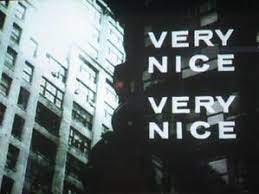After watching pioneering experimental filmmaker Arthur Lipsett’s first film Very Nice Very Nice, I was struck by how many decisions needed to be made during the creation of the seven-minute short.
For those unfamiliar, Very Nice Very Nice is a audio/visual collage of still images, stock footage, and audio B-roll from various Canadian projects that Lipsett helped edit in the early sixties.
I am not going to pretend I understand the meaning of the film, or what his intention was while making it. As with most experimental films, the fulfillment I get is from immersion. Just giving in and letting the film wash over me. By removing all other distractions and concentrating on the sensory input the film-makers have designed, I can experience specific moods or tones or sensations. At least in the good ones.
Very Nice, Very Nice is one of the good ones, and it provided me with a sad and anxious few minutes, and had me thinking about how we as a species have developed systems and societal structures that are holding us all back.
That’s my experience with it, though. Yours, if you choose to watch it (Free on YouTube) may be different.
As mentioned at the top of the article, an incredible amount of decisions went into producing this short. What audio to use, what images to show, how long to show them far, the order in which to show them, the tone of the soundtrack, the manipulation of the images, the timing and the structure and the build-up to the final line and visual.
These are all intentional choices that had to be made and decided upon, and sometimes, yes, even stumbled into. In 1961, this was no easy task. Actual film needed to be cut and recut by hand. Audio strips needed to sync up. Optical effects needed to be sent to a lab to develop and complete.
In the digital era, this has been a lot easier to do. You can cut and recut and try new things without dealing with the physical limitations of film, all from the comfort of a home PC.
Now, in the era of AI, this can even be done without making the decisions yourself. You can tell a piece of software to cut your existing footage in a specific style and it will do it itself. Going even further, you can just tell an AI to create the footage itself out of thin air.
Incredible technology! Technology probably developed by SATAN HIMSELF.
Art should be hard. I’m not being ableist and saying we should keep up barriers that hinder people from creating art. What I’m saying is that when something is harder to do, we have to think longer about what is the correct way to do it. “Correct” in this context, is the way the creator wants to actualize the feeling or tone or idea they are trying to present. It’s a very personal decision, and a series of those decisions is what creates art.
Yes, having an easier way to make that happen can be great, but it also removes that initial question that people should be asking themselves: Is this the right decision for me to make? Technology has gotten to a point where we don’t need to ask that question. Either because it will be answered for us, or because if we are wrong it will be easy to fix. But not having to ask the question dilutes what we do.
I’m not asking anyone here to get a typewriter or a film camera and go back to the old ways. (Although it would be cool if you did!) But I am saying that you should think about every decision that goes into your art, and you should definitely avoid and actively destroy any AI that purports to create it.

